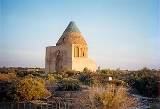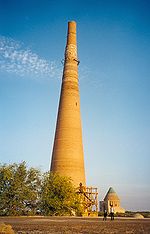
Kunya Urgench
Encyclopedia
Konye-Urgench also known as Konya-Urgench, Old Urgench or Urganj, is a municipality of about 30,000 inhabitants in north-eastern Turkmenistan
, just south from its border with Uzbekistan
. It is the site of the ancient town of Ürgenç (Urgench), which contains the unexcavated ruins of the 12th-century capital of Khwarezm
. Since 2005, the ruins of Old Urgench have been protected by UNESCO
as a World Heritage Site
. (See List of World Heritage Sites in Turkmenistan)
Formerly situated on the Amu-Darya River, Old Ürgenç was one of the greatest cities on the Silk Road
. Its foundation date is uncertain, but the extant ruins of the Kyrkmolla fortress have been dated (rather ambitiously) to the Achaemenid period. The 12th and early 13th centuries were the golden age of Ürgenç, it became the capital of Khorezm Empire and it surpassed in population and fame all other Central Asian cities barring Bukhara
. In 1221, Genghis Khan
razed it to the ground
in one of the bloodiest massacres in human history.
 The city was revived after Genghis's assault, but the sudden change of Amu-Darya's course to the north and the town's destruction again in the 1370s, this time by Timur
The city was revived after Genghis's assault, but the sudden change of Amu-Darya's course to the north and the town's destruction again in the 1370s, this time by Timur
, forced the inhabitants to leave the site forever.
The area was later inhabited by Turkmen
in 1831, but they built outside the old town, using it as a graveyard.
A new town of Urgench
was developed to the Southeast, in present-day Uzbekistan
. First archeological research on the old city site was conducted by Alexander Yakubovsky in 1929.
Most of Ürgenç's monuments have completely or partly collapsed. Nowadays, the site contains three small mausoleum
s of the 12th century and the more elaborate 14th-century Törebeg Hanym Mausoleum, which was much restored in the 1990s.
The most striking extant landmark of Old Urgench is the early 11th-century Gutluk-Temir Minaret, which, at 60 meters, used to be the tallest brick minaret
prior to the construction of the Minaret of Jam
- which was later surpassed by the Qutb Minar when it was completed in 1368. Also of note is the Il-Arslan Mausoleum - the oldest standing monument: a conical dome of 12 facets, housing the tomb of Mohammed II
's grandfather, Il-Arslan
, who died in 1172. Somewhat to the north, sprawls a vast medieval necropolis
.
Turkmenistan
Turkmenistan , formerly also known as Turkmenia is one of the Turkic states in Central Asia. Until 1991, it was a constituent republic of the Soviet Union, the Turkmen Soviet Socialist Republic . Turkmenistan is one of the six independent Turkic states...
, just south from its border with Uzbekistan
Uzbekistan
Uzbekistan , officially the Republic of Uzbekistan is a doubly landlocked country in Central Asia and one of the six independent Turkic states. It shares borders with Kazakhstan to the west and to the north, Kyrgyzstan and Tajikistan to the east, and Afghanistan and Turkmenistan to the south....
. It is the site of the ancient town of Ürgenç (Urgench), which contains the unexcavated ruins of the 12th-century capital of Khwarezm
Khwarezm
Khwarezm, or Chorasmia, is a large oasis region on the Amu Darya river delta in western Central Asia, which borders to the north the Aral Sea, to the east the Kyzylkum desert, to the south the Karakum desert and to the west the Ustyurt Plateau...
. Since 2005, the ruins of Old Urgench have been protected by UNESCO
UNESCO
The United Nations Educational, Scientific and Cultural Organization is a specialized agency of the United Nations...
as a World Heritage Site
World Heritage Site
A UNESCO World Heritage Site is a place that is listed by the UNESCO as of special cultural or physical significance...
. (See List of World Heritage Sites in Turkmenistan)
Formerly situated on the Amu-Darya River, Old Ürgenç was one of the greatest cities on the Silk Road
Silk Road
The Silk Road or Silk Route refers to a historical network of interlinking trade routes across the Afro-Eurasian landmass that connected East, South, and Western Asia with the Mediterranean and European world, as well as parts of North and East Africa...
. Its foundation date is uncertain, but the extant ruins of the Kyrkmolla fortress have been dated (rather ambitiously) to the Achaemenid period. The 12th and early 13th centuries were the golden age of Ürgenç, it became the capital of Khorezm Empire and it surpassed in population and fame all other Central Asian cities barring Bukhara
Bukhara
Bukhara , from the Soghdian βuxārak , is the capital of the Bukhara Province of Uzbekistan. The nation's fifth-largest city, it has a population of 263,400 . The region around Bukhara has been inhabited for at least five millennia, and the city has existed for half that time...
. In 1221, Genghis Khan
Genghis Khan
Genghis Khan , born Temujin and occasionally known by his temple name Taizu , was the founder and Great Khan of the Mongol Empire, which became the largest contiguous empire in history after his death....
razed it to the ground
Mongol invasion of Central Asia
The Mongol invasion of Central Asia occurred after the unification of the Mongol and Turkic tribes on Mongolian plateau in 1206. It finally completed when Genghis Khan conquered the Khwarizmian Empire in 1221....
in one of the bloodiest massacres in human history.

Timur
Timur , historically known as Tamerlane in English , was a 14th-century conqueror of West, South and Central Asia, and the founder of the Timurid dynasty in Central Asia, and great-great-grandfather of Babur, the founder of the Mughal Dynasty, which survived as the Mughal Empire in India until...
, forced the inhabitants to leave the site forever.
The area was later inhabited by Turkmen
Turkmen people
The Turkmen are a Turkic people located primarily in the Central Asian states of Turkmenistan, Afghanistan, and northeastern Iran. They speak the Turkmen language, which is classified as a part of the Western Oghuz branch of the Turkic languages family together with Turkish, Azerbaijani, Qashqai,...
in 1831, but they built outside the old town, using it as a graveyard.
A new town of Urgench
Urgench
Urgench is a city in western Uzbekistan. It is the capital of the Khorezm Province, on the Amu Darya River and the Shavat canal. The city is situated 450 km west of Bukhara across the Kyzyl Kum Desert. It is located at latitude 41° 32' 60N longitude 60° 37' 60E, at an altitude of 91 meters.The...
was developed to the Southeast, in present-day Uzbekistan
Uzbekistan
Uzbekistan , officially the Republic of Uzbekistan is a doubly landlocked country in Central Asia and one of the six independent Turkic states. It shares borders with Kazakhstan to the west and to the north, Kyrgyzstan and Tajikistan to the east, and Afghanistan and Turkmenistan to the south....
. First archeological research on the old city site was conducted by Alexander Yakubovsky in 1929.
Most of Ürgenç's monuments have completely or partly collapsed. Nowadays, the site contains three small mausoleum
Mausoleum
A mausoleum is an external free-standing building constructed as a monument enclosing the interment space or burial chamber of a deceased person or persons. A monument without the interment is a cenotaph. A mausoleum may be considered a type of tomb or the tomb may be considered to be within the...
s of the 12th century and the more elaborate 14th-century Törebeg Hanym Mausoleum, which was much restored in the 1990s.
The most striking extant landmark of Old Urgench is the early 11th-century Gutluk-Temir Minaret, which, at 60 meters, used to be the tallest brick minaret
Minaret
A minaret مناره , sometimes مئذنه) is a distinctive architectural feature of Islamic mosques, generally a tall spire with an onion-shaped or conical crown, usually either free standing or taller than any associated support structure. The basic form of a minaret includes a base, shaft, and gallery....
prior to the construction of the Minaret of Jam
Minaret of Jam
The Minaret of Jam is a UNESCO World Heritage Site in western Afghanistan. It is located in the Shahrak District, Ghor Province, by the Hari River. The 65-metre high minaret, surrounded by mountains that reach up to 2400m, was built in the 1190s, entirely of baked-bricks...
- which was later surpassed by the Qutb Minar when it was completed in 1368. Also of note is the Il-Arslan Mausoleum - the oldest standing monument: a conical dome of 12 facets, housing the tomb of Mohammed II
Muhammad II of Khwarezm
Ala ad-Din Muhammad II was the ruler of the Khwarezmid Empire from 1200 to 1220. His ancestor was a Turkic slave who eventually became a viceroy of a small province named Khwarizm. After his father died, Muhammad inherited his father's lands, and it was from there he began expanding outwards...
's grandfather, Il-Arslan
Il-Arslan
Il-Arslan was Khwarazm Shah from 1156 until his death. He was the son of Atsïz.In 1152 Il-Arslan was made governor of Jand, an outpost on the Syr Darya which had recently been reconquered, by his father. In 1156 Atsïz died and Il-Arslan succeeded him as Khwarazm-Shah...
, who died in 1172. Somewhat to the north, sprawls a vast medieval necropolis
Necropolis
A necropolis is a large cemetery or burial ground, usually including structural tombs. The word comes from the Greek νεκρόπολις - nekropolis, literally meaning "city of the dead"...
.

